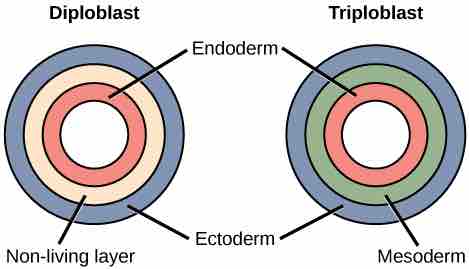Animal Characterization Based on Features of Embryological Development
Most animal species undergo a separation of tissues into germ layers during embryonic development. These germ layers are formed during gastrulation, developing into the animal's specialized tissues and organs. Animals develop either two or three embryonic germs layers . Radially-symmetrical animals are diploblasts, developing two germ layers: an inner layer (endoderm) and an outer layer (ectoderm). Diploblasts have a non-living layer between the endoderm and ectoderm. Bilaterally-symmetrical animals are called triploblasts, developing three tissue layers: an inner layer (endoderm), an outer layer (ectoderm), and a middle layer (mesoderm).

Germ development in embryogenesis
During embryogenesis, diploblasts develop two embryonic germ layers: an ectoderm and an endoderm. Triploblasts develop a third layer, the mesoderm, between the endoderm and ectoderm
Germ Layers
Each of the three germ layers in a blastula, or developing ball of cells, becomes particular body tissues and organs. The endoderm gives rise to the stomach, intestines, liver, pancreas, and the lining of the digestive tract, as well as to the lining of the trachea, bronchi, and lungs of the respiratory tract. The ectoderm develops into the outer epithelial covering of the body surface and the central nervous system. The mesoderm, the third germ layer forming between the endoderm and ectoderm in triploblasts, gives rise to all muscle tissues (including the cardiac tissues and muscles of the intestines), connective tissues such as the skeleton and blood cells, and most other visceral organs such as the kidneys and the spleen.
Presence or Absence of a Coelom
Triploblasts can be differentiated into three categories: those that do not develop an internal body cavity called a coelom (acoelomates), those with a true coelom (eucoelomates), and those with "false" coeloms (pseudocoelomates) .
Differentiation in triploblasts
Triploblasts may be (a) acoelomates, (b) eucoelomates, or (c) pseudocoelomates. Acoelomates have no body cavity. Eucoelomates have a body cavity within the mesoderm, called a coelom, which is lined with mesoderm. Pseudocoelomates also have a body cavity, but it is sandwiched between the endoderm and mesoderm.
Acoelomates
Triploblasts that do not develop a coelom are called acoelomates: their mesoderm region is completely filled with tissue. Flatworms in the phylum Platyhelminthes are acoelomates.
Eucoelomates
Eucoelomates (or coelomates) have a true coelom that arises entirely within the mesoderm germ layer and is lined by an epithelial membrane. This coelomic cavity represents a fluid-filled space that lies between the visceral organs and the body wall. It houses the digestive system, kidneys, reproductive organs, and heart, and it contains the circulatory system. The epithelial membrane also lines the organs within the coelom, connecting and holding them in position while allowing them some free motion. Annelids, mollusks, arthropods, echinoderms, and chordates are all eucoelomates. The coelom also provides space for the diffusion of gases and nutrients, as well as body flexibility and improved animal motility. The coelom also provides cushioning and shock absorption for the major organ systems, while allowing organs to move freely for optimal development and placement.
Pseudocoelomates
The pseudocoelomates have a coelom derived partly from mesoderm and partly from endoderm. Although still functional, these are considered false coeloms. The phylum Nematoda (roundworms) is an example of a pseudocoelomate.
Embryonic Development of the Mouth
Bilaterally symmetrical, tribloblastic eucoelomates can be further divided into two groups based on differences in their early embryonic development. These two groups are separated based on which opening of the digestive cavity develops first: mouth (protostomes) or anus (deuterostomes) . The word protostome comes from the Greek word meaning "mouth first. " The protostomes include arthropods, mollusks, and annelids. Deuterostome originates from the word meaning "mouth second. " Deuterostomes include more complex animals such as chordates, but also some simple animals such as echinoderms.
Early embryonic development in eucoelomates
Eucoelomates can be divided into two groups based on their early embryonic development. In protostomes, part of the mesoderm separates to form the coelom in a process called schizocoely. In deuterostomes, the mesoderm pinches off to form the coelom in a process called enterocoely.
Development of the Coelom
The coelom of most protostomes is formed through a process called schizocoely, when a solid mass of the mesoderm splits apart and forms the hollow opening of the coelom. Deuterostomes differ in that their coelom forms through a process called enterocoely, when the mesoderm develops as pouches that are pinched off from the endoderm tissue. These pouches eventually fuse to form the mesoderm, which then gives rise to the coelom.
Embryonic Cleavage
Protostomes undergo spiral cleavage: the cells of one pole of the embryo are rotated and, thus, misaligned with respect to the cells of the opposite pole. This spiral cleavage is due to the oblique angle of the cleavage. Protostomes also undergo determinate cleavage: the developmental fate of each embryonic cell is pre-determined. Deuterostomes undergo radial cleavage where the cleavage axes are either parallel or perpendicular to the polar axis, resulting in the alignment of the cells between the two poles. Unlike protostomes, deuterostomes undergo indeterminate cleavage: cells remain undifferentiated until a later developmental stage. This characteristic of deuterostomes is reflected in the existence of familiar embryonic stem cells, which have the ability to develop into any cell type.